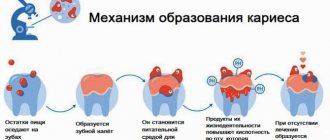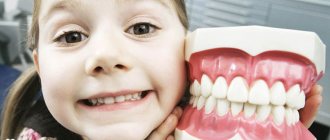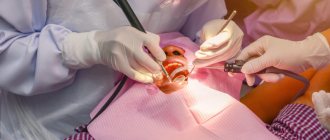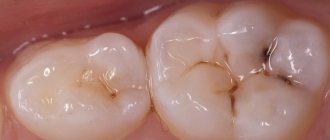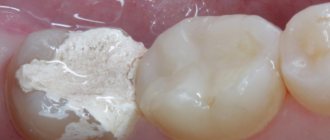Caries of the front teeth can lead to chipped enamel, severe pain and even a change in diction. In addition, it creates an aesthetic problem, as it makes the smile unattractive. If left untreated, it spreads to adjacent incisors. We will tell you why caries occurs on the front surface of the tooth, how it manifests itself and how to get rid of it.
The front teeth of a person are called 8 incisors and 4 canines, which fall into the smile zone. Any enamel damage in this area looks unaesthetic. In this case, most often the front teeth are affected by caries - a slow-moving pathological destruction of the hard tissues of the tooth (dentine).
In this article
- Causes of caries on the front teeth
- What caries looks like in the front teeth: symptoms
- Types of caries in front teeth
- Types of caries of incisors according to the form of occurrence
- Types by localization of the pathological process
- Black classification
- Diagnostics
- How to treat caries on the front teeth
- How to treat caries at an early stage
- Treatment for medium and deep stages of caries
- Treatment for severe crown lesions
- Treatment of caries of anterior teeth in children
- Complications
- Prevention of caries
The most common cause of this disease is the proliferation of cariogenic microbes. However, there are other factors leading to its development. Let us tell you why caries of the front teeth begins.
Causes of caries on the front teeth
Doctors distinguish two groups of caries factors - local and general. The first include:
- Poor oral hygiene. Lack of dental care or improper brushing leads to the formation of deposits on the enamel and gums. Over time, they accumulate and bacteria begin to multiply in them, which destroy hard tissue.
- Disruption of the salivary glands. Saliva washes germs off your teeth and neutralizes toxins created by germs in your mouth. If it is produced in insufficient quantities, the number of microorganisms increases, and the amount of their metabolic products also increases. As a result, they cause decay and damage to dentin.
- Anatomical features of the jaw and tooth structure. Their crowding leads to the rapid accumulation of plaque, as more places appear in the oral cavity that are difficult for toothbrushes to reach. An incorrect bite can also lead to tooth decay. In some cases, it becomes a consequence of carious lesions.
- Poor nutrition. The bacteria that cause tooth decay feed on carbohydrates. The more a person eats sweets, the higher the likelihood of pathology.
There are also common factors for the development of caries on the front teeth. Among them:
- Biological: heart and vascular diseases, endocrine pathologies, gastrointestinal problems, medications, weak immunity, genetic predisposition, stress.
- Environmental factors: poor ecology, unfavorable climate, drinking soft water devoid of minerals, lack of sunlight.
- Social: work in hazardous conditions, childhood, etc.
In children, caries occurs more often than in adults, in women - more often than in men, in white people - more often than in representatives of the Negroid race. This disease affects the front teeth more often than molars and premolars. This is due to the fact that the enamel on them is thinner than on chewing teeth, so they are more vulnerable to external factors and microbes. Let us tell you how caries manifests itself on the front teeth.
How does caries form?
The causes of caries are poor hygiene and the presence of bacteria in the oral cavity.
There are many bacteria in the human oral cavity. These bacteria feed on food debris that remains on the surface of the enamel after eating. Bacteria “love” foods high in carbohydrates: sweets, flour. During their life, bacteria produce acid, which destroys teeth.
Caries occurs in both adults and children. This disease spreads in each person at a different rate.
Factors contributing to the rapid development of caries:
- insufficient or lack of oral hygiene;
- excess carbohydrate foods: flour products, sweets, carbonated drinks;
- low buffering capacity of saliva, when acids and alkalis are not sufficiently neutralized in the oral cavity;
- insufficient fluorine and calcium content in enamel;
- lack of vitamins and minerals in the body;
- severe somatic pathologies suffered in childhood (tuberculosis, rickets);
- reduced immunity.
Answering a frequent question from patients: “Why do caries form on teeth?”, we note that the most important factor is insufficient hygiene. All dentists strongly recommend brushing your teeth regularly and using floss to clean the gaps. Without careful hygiene, bacteria will destroy teeth one by one, leading to serious complications.
What caries looks like in the front teeth: symptoms
Symptoms depend on the degree and type of disease. The main symptoms of incisor caries:
- sensitivity of the front teeth: accompanied by pain when the enamel is exposed to sour, sweet, hot or cold foods;
- the appearance of dark or white spots on the enamel, which indicate areas of demineralization;
- visible destruction of crowns, chips, cracks, formation of cavities that gradually increase;
- inflammation of the internal tissues of the pulp (pulpitis) or the ligaments holding the tooth in the alveolus (periodontitis);
- putrid odor from the mouth, which can only be hidden with the help of mint toothpaste or chewing gum.
At the initial stage, the disease may not manifest itself, but if any of the listed signs occur, you should consult a dentist. There are also specific symptoms characteristic of one form or another of caries. Let's look at the types of this disease.
If your front tooth hurts after treatment
When performing treatment procedures related to cleaning canals and filling a tooth, the patient may experience pain caused by the dentist’s intervention. As a rule, the healing process occurs quite quickly, and after 1-3 days the patient stops feeling pain. To prevent inflammation and relieve wound pain, the doctor prescribes medications (for example, Nimesil).
If the pain worsens over time, you should definitely visit a dentist. There is a possibility that caries is not completely cured and an inflammatory process has begun in the canal. Repeated treatment may be required.
Types of caries in front teeth
Caries on the incisors is classified on several grounds. So, according to the degree of development it is:
- Beginners. An unnatural white spot can be seen on the surface of the enamel, which is a consequence of the leaching of minerals from this area of the tooth. At this stage, caries is treated with the help of remineralization - restoring the balance of minerals in the enamel structure.
- Superficial. If the initial stage of the disease is left unattended, the white spot begins to darken and becomes rough to the touch. There is increased sensitivity to sweet and sour foods, and to cold.
- Average Dark yellow or brown cavities form on the tooth. Their sizes and shapes may vary. Lack of treatment leads to the growth of pathological areas.
- Deep. The last stage of caries, which is accompanied by the destruction of hard tissues. The tooth may break into several pieces. The dark spot spreads over the entire surface of the enamel, penetrating into the dentin, so the painful sensations intensify. A tooth can hurt just like that, without being affected by food or drinks.
It is advisable to get rid of caries on the front teeth at the initial or superficial stage, because it progresses quickly in this area of the jaw.
Symptoms and types of cervical caries
Symptoms of cervical caries may vary depending on the stage of its development. Therefore, below we will consider the stages of development of cervical caries and describe the signs characteristic of each of them.
Cervical caries in the spot stage
At this phase of caries development, a small dark or light spot may appear in the cervical area of the tooth. The pain of the patient with cervical caries does not bother the spots.
Superficial cervical caries
At this stage of cervical caries, the surface layers of tooth enamel are destroyed. It may become rough and uneven to the touch. Increased sensitivity of the diseased tooth to temperature factors - too hot or cold food - may also occur.
Middle cervical caries
The carious lesion of the tooth increases in size, the dentin of the tooth becomes increasingly soft. But at the same time, the destructive process at this stage of cervical caries has not yet reached the pulp. A person may experience tooth pain when brushing their teeth or biting into food. But this pain goes away quite quickly, which is why people are in no hurry to treat caries, thinking that the tooth will go away on its own.
Deep cervical caries
Destruction at this stage of caries reaches the pulp and the risks of pulpitis become extremely high.
In a tooth with advanced caries, severe pain may occur when the tooth comes into contact with food. The tooth begins to hurt especially badly if a piece of food gets into the carious cavity. After eliminating the irritant, the pain may go away. Cervical caries also has another form, which dentists call circular caries. It affects several teeth in a row at once, and carious destruction runs along the tooth at the neck like a belt, that is, from all sides. It is very, very difficult to treat circular caries!
The form and stage of development of cervical caries are determined by the dentist during diagnostic measures.
Types of caries of incisors according to the form of occurrence
According to the form of occurrence, the following types of caries are distinguished:
- Acute: develops rapidly, in 10-14 days the disease passes through the initial, superficial and middle stages.
- Chronic: occurs slowly, gradually destroying the enamel and turning it dark. Caries takes on this form when the main factors that provoked the disease no longer affect the body, but no treatment was provided.
- Multiple: caries occurs in several places on the same tooth or on different teeth.
- Secondary: formed under an installed filling.
In this case, secondary or multiple can occur in both acute and chronic forms. For some people, caries practically does not go away, but does not bother them with pain or other symptoms. However, their teeth slowly deteriorate, increasing the risk of their removal.
How is cervical caries diagnosed?
If you are careful, you can determine for yourself whether you have cervical caries or not. To do this, you need to brush your teeth well and then carefully examine their cervical area in sufficient lighting. Any spots in the area of the neck of the tooth indicate that the tooth is affected by cervical caries, and it is urgently necessary to treat it.
In a clinical setting, not only visual examination, but also professional techniques are used to diagnose cervical caries. Among them:
Vital staining technique
This technique for diagnosing cervical caries involves cleaning dental surfaces from plaque, and then treating them with a special coloring solution. A few minutes after application, the solution is washed off with water and if colored spots remain on the tooth enamel in the area of the tooth neck, this indicates the development of cervical caries.
Transillumination
This method for diagnosing cervical caries uses a beam of cold light, which is absolutely harmless to tooth enamel, but at the same time clearly shows the specialist carious damage.
Light diagnostics of caries is carried out in a dark room and within a couple of minutes allows you to make an accurate diagnosis! Another method for diagnosing cervical caries is laser diagnostics. When a carious lesion is detected, it will be displayed on the device display, and the device will also emit a characteristic sound signal. Laser diagnostics of cervical caries is an expensive pleasure, but at the same time the most effective!
Based on the diagnostic data and the stage of development of cervical caries determined with its help, the most effective method of its treatment is selected.
Types by localization of the pathological process
Caries of the anterior teeth is localized:
- Cervical: caries begins near the neck in the gum area or under it. The main reason for this is poor oral hygiene.
- Interdental: carious lesion is observed between two incisors. Often this type of disease occurs with a small gap between them. This is where food debris gets stuck, which decomposes and causes damage to the enamel.
- Fissure: affects the grooves on the tips of the teeth. Typically, this form of the disease develops on molars, rather than on incisors and canines.
Most often, caries of the front teeth is interdental. If left untreated, the stain spreads to both incisors. If the disease starts, a hole will form between the teeth, which will be difficult to repair. At any moment, enamel and hard tissues can split into several parts.
Features of treatment of carious damage to anterior teeth
Caries on the frontal part is clearly visible. This is very convenient for diagnosing the disease, but significantly complicates the process of its treatment.
In such a situation, the dentist is required to have the maximum level of professionalism, since a number of specific factors have to be taken into account:
- the need to maintain an attractive appearance of teeth;
- even the slightest flaws will be clearly visible;
- thinner and more fragile tooth enamel;
- increased sensitivity of teeth.
The teeth in front are often crowded together, with small or no gaps between them. This further complicates the dentist’s work, especially in the case of interdental caries.
Black classification
American dentist Green Black developed his own classification of caries, dividing it into classes:
- 1st class: carious lesions are localized in fissures;
- 2nd class: the pathological focus is localized between the molars;
- 3rd class: caries affects the areas between the incisors and canines;
- 4th class: the disease develops along the edges of the front teeth;
- 5th class: the affected area includes the cervical area;
- 6th grade: caries affects the cutting edges of the front teeth.
During the diagnosis, the doctor determines the degree and type of caries of the front teeth, based on which he selects treatment.
About the cost of treatment
Most often, a paradoxical situation occurs: a person wants to save money on the dentist and waits until the tooth is destroyed. But you need to understand that the later you see a doctor, the more expensive his services will cost. If the problem has already appeared, it will need to be solved, and the sooner, the cheaper. Conventional preparation of a carious cavity in the early stages costs only about 4,000 rubles. If you wish to install ceramic fillings, the amount will increase to 10 thousand rubles. But some patients wait until the destruction is complete, and then they have to pay 30-50 thousand for one incisor.
We described in detail how caries of the front teeth in adults is treated. For the process to go well, it is better to choose a good private clinic. You can contact: there the work with clients is at a high level, they feel comfortable physically and psychologically. In addition, the clinic received the title of one of the best in Russia in the StartSmile rating. And on the site there are often many special offers and promotions that will significantly reduce the cost of services. Hurry up to sign up for a consultation!
Diagnostics
It is not always possible to detect caries at the initial stage, since it can be localized on the back side of the tooth. Therefore, dentists recommend coming for an oral examination every six months. During diagnosis, the doctor uses a detector staining method. It allows you to distinguish caries from other similar diseases: fluorosis, enamel hypoplasia, tetracycline teeth, etc.
The dentist can also probe the cavity to assess the nerve's response to exposure. If deep caries is suspected, the patient is sent for an x-ray of the jaw. After the examination, the type of treatment is determined.
Prices for treatment of cervical caries in Moscow
How much does it cost to cure cervical caries in Moscow? It is difficult to give a definite answer to this question, because the price of the service will depend on many different factors. In particular, the stage of development of the disease is taken into account. Cervical caries in the spot stage is treated quickly and inexpensively - the price of the service in this case will range from 2000 to 4500 rubles.
If, during the development of cervical caries, the infection managed to penetrate into the tooth canals, the cost of treatment will increase significantly and can range from 6,000 to 10,000 rubles.
There is only one way to find out the exact price for treatment of cervical caries - by visiting the dentist's office. After examination and diagnosis, the specialist will draw up a treatment plan for you with a clear indication of the final price for the service.
Do you need detailed professional advice on the treatment and prevention of cervical caries? Contact our dental clinic in Moscow - Venstom! You can make an appointment with our specialists by calling the contact phone numbers of our clinic or by writing to the chat on our website!
Treatment for medium and deep stages of caries
Medium and deep caries are already serious lesions that cannot be eliminated with fluoride and calcium. It is necessary to drill into the tooth, clearing it of germs and dead tissue, in order to install a filling. In most cases, the procedure is performed under local anesthesia.
We list the stages of treatment:
- removal of caries-affected areas with a drill;
- disinfection of the cleaned surface;
- drying the cavity with an air stream;
- installation of a dental dam;
- layer-by-layer application of filling composition;
- grinding and polishing of the filling.
At the final stage, the patient has a paper plate inserted between the teeth to evaluate the bite. If there is any discomfort, you must inform the doctor, he will continue grinding and polishing.
Features of pathology in children
It is common for children to replace baby teeth with permanent ones, but this does not mean that temporary teeth do not need to be treated - firstly, the baby will be bothered by pain, and secondly, it is important to eliminate the source of chronic infection.
Distinctive features of caries in children:
Children need help brushing their teeth; adults must constantly monitor the process, otherwise caries may occur.
Treatment for severe crown lesions
If caries affects more than 50% of the incisor or canine tooth, it will not be possible to install a filling. After removing the carious areas, the patient is sent to an orthopedist for installation of an orthodontic structure: a bridge, crown, veneer or lumineer. They allow you to hide a cosmetic defect that appears after an illness.
If the tooth is completely destroyed by caries, but the root remains, the doctor installs a pin and a crown. If a tooth is completely lost, an implant will be required. This is one of the most expensive dental procedures.
Treatment of caries of anterior teeth in children
Treatment of caries in children and adults follows the same stages. However, children are more difficult to treat because they are afraid of doctors. Parents must properly prepare their child for a visit to the doctor. To relieve fear, experienced dentists turn treatment into a game.
Some parents believe that there is no need to treat baby teeth, since they will fall out anyway. However, this opinion is wrong. Caries can spread to soft tissues and ligaments, which subsequently affects the condition of the molar.
Treatment methods for cervical caries
How will cervical caries be treated in dentistry? The answer to this question will depend on the stage of development of cervical caries. Below we will look at the features of treating caries in the cervical area of the tooth, depending on the phase of its development.
Treatment of cervical caries in the spot stage
As we already wrote above, to treat cervical caries of a spot, it is not necessary to drill out the tooth.
At this stage of caries development, special preparations rich in calcium and other minerals beneficial to enamel are used. ICON technology can also be used. USEFUL TO KNOW: By seeking caries treatment in a timely manner, you can maintain the health of your teeth and avoid the procedure of tooth drilling, which is unpleasant for many. In the early stages, caries can be treated without a drill - using special remineralizing drugs and technologies that restore the integrity of tooth enamel!
Superficial cervical caries can also be cured without a drill. The treatment regimen will be similar to the treatment method for cervical caries at the spot stage.
Prevention of caries
It is better to try to prevent tooth decay than to treat it. Adhere to the following rules:
- Brush your teeth twice a day. However, this must be done correctly. Check with your doctor about the algorithm for cleaning your mouth with a toothbrush.
- Use additional oral hygiene products: dental floss, rinses, irrigators.
- Change your toothbrush (or brush head if you use an electric model) every 3 months.
- Protect your teeth from mechanical damage. When playing sports, wear a mouth guard, do not chew nuts in the shell, etc.
- Reduce your consumption of sugary foods; Try not to eat too hot or very cold foods.
- Make an appointment with your dentist every six months for a preventive examination, even if there are no complaints.
You can avoid caries even if you have a genetic predisposition to it. You just need to monitor your dental health and not neglect the above rules. Any symptom - bad breath, pain, tooth sensitivity, bleeding gums - should be a reason for an emergency visit to the doctor.
How is caries treated?
The treatment is carried out in professional dentistry by a general practitioner and is absolutely painless. This treatment is carried out in one visit, and several teeth can be treated in one visit.
Sequence of treatment stages:
- Examination of the oral cavity. Carrying out diagnostics: a targeted diagnostic image of one tooth or computed tomography of the jaws (if multiple caries is detected during the examination). This is done in order to make an accurate diagnosis and see the volume of destroyed tissue.
- Local anesthesia: selected individually according to health conditions. Only after the desired area of the oral cavity has become numb does the doctor proceed to the next manipulations.
- Placement of isolation: the doctor places a rubber dam on the desired area - this is a latex plate that isolates the tooth from the rest of the oral cavity. The rubber dam creates comfortable conditions for the doctor, the patient, and also allows you to create dry, sterile conditions for placing a filling. This is necessary for the filling to serve for a long time and with high quality.
- Preparation of enamel, dentin: necrectomy. The doctor uses a drill to drill out the destroyed tissue.
- Treating the cavity with antiseptic solutions, applying an adhesive - a special solution that, like glue, reliably bonds hard tissue to the filling.
- Filling with light-curing materials. The anatomical shape of the tooth is restored, and the color is carefully selected.
- Polishing and grinding so that the filling does not feel different from your own teeth. Also, using special guidelines, the doctor checks whether the filling is too high or does not interfere with the normal closure of the jaws. Excess is removed, sharp edges are sanded.
- The doctor gives recommendations after treatment. If a tooth has been severely damaged by caries, then in addition to a filling, an orthopedic onlay or crown may be required. This is due to the fact that the filling is not as strong as enamel. Over time, cracks and chips are possible. Orthopedic structures will help protect the treated tooth from these complications.
After these stages, the tooth is completely free of caries. Next, you will need to maintain regular hygiene, come for preventive examinations and professional cleaning.
